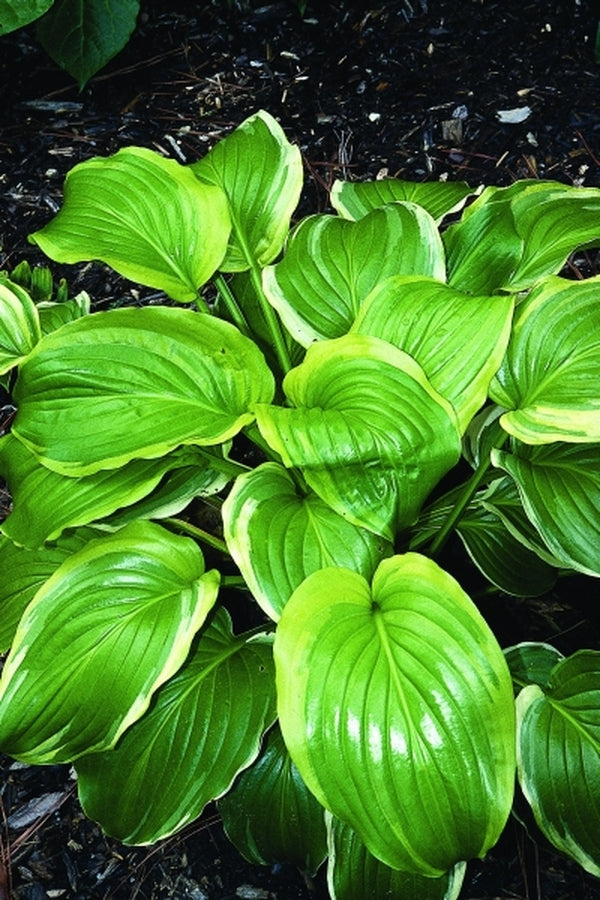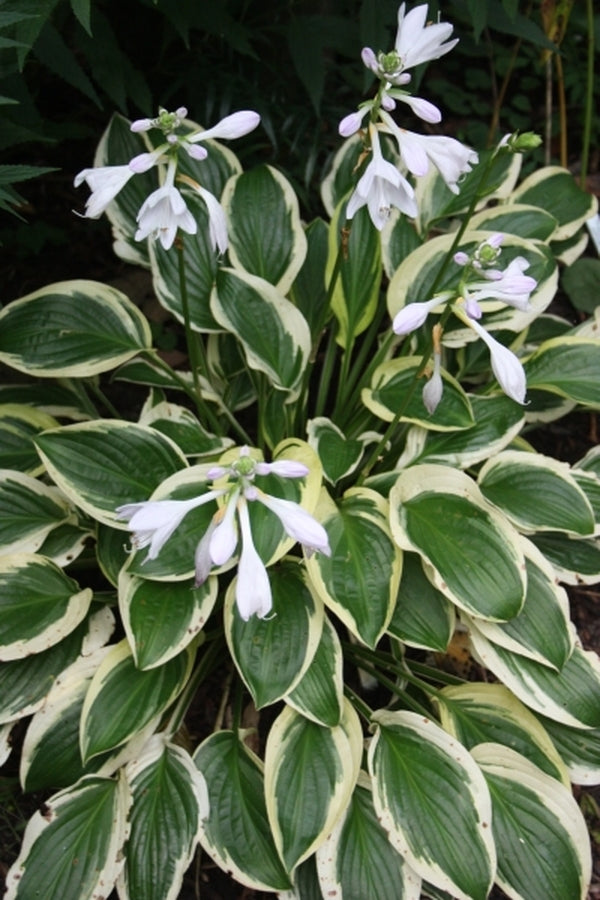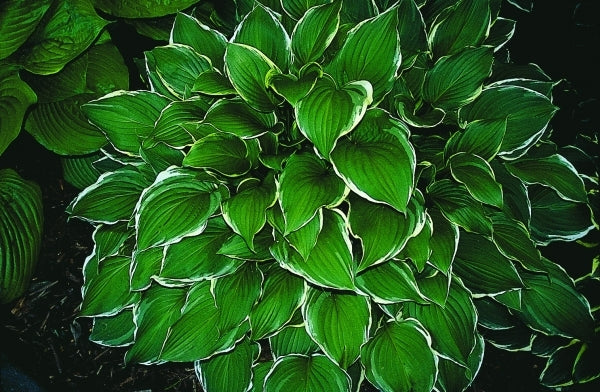Wouldn't it be nice if all of the flowers in our gardens were fragrant? At one time, fragrance was a very important element in the garden, but then things changed. The next generation of gardeners seemed to be more interested in larger, showier flowers at the expense of "old fashioned" traits like fragrance. Fortunately, as with outdated clothing, everything comes back in fashion. Nowhere is this more true than in the world of gardening. Many old fashioned "passalong plants" that were prized for their fragrance are storming back into vogue.
Fragrant hostas are certainly not a new thing on the gardening scene, although some folks look at me sort of funny when I mention that there are hostas with fragrant flowers. In reality, many of our grandparents actually grew what has become known as the old fashioned "August lily". Indeed this large hosta, Hosta plantaginea, was first imported to England in 1790, and to the United States afterwards.
Hosta plantaginea - The White Sheep of the Hostas
Hosta plantaginea is certainly the "white sheep" of the hostas family for a variety of reasons. First, it is one of the few hosta species that originated in China (as opposed to Korea and Japan). Hosta plantaginea is also the southern most naturally occurring hosta species making it more heat loving than other members of the genus.
The flowering habit of Hosta plantaginea certainly puts it in a class by itself. First of all the flowers are enormous by hosta standards...6+ inches long and pure white, as compared to 1-2" long and purple for most hostas. Virtually every hosta except Hosta plantaginea has flowers that open around 7am in the morning. Hosta plantaginea on the other hand opens at 4pm in the afternoon. Educated scientists have still not figured out why this bizarre characteristic was selected for in the wild. The strong honeysuckle like fragrance of the old August Lily is absent in all other naturally occurring hosta species.
Hosta plantaginea, as the name 'August Lily' suggests, bloom in late summer. This is in stark contrast to the majority of the Hosta sieboldiana based hybrids that flower from late April through June.
Hosta plantaginea
Another little noticed attribute of Hosta plantaginea is it's ability to reflush new foliage during the summer months. While most hostas species send up all of their foliage in the spring months, H. plantaginea is one of the only species that will continue to produce new leaves all summer long. This is a particular advantage when the original spring foliage becomes damaged or diseased, as can often occur in southern gardens.
If there are any drawbacks to Hosta plantaginea, it would be its desire to emerge much too early in the spring. Due to it's heritage in the southern part of China where spring arrived early, Hosta plantaginea tries to emerge from it's winter rest quite early...often in March. In most southern gardens, this meant that a late spring frost would take its toll on the clump, often burning it back the ground. In more northerly climates, Hosta plantaginea has also proved to be a bit less hardy than the more northerly naturally occurring species.
Because Hosta plantaginea has a dramatically different bloom time, the number of hybrids that display the fragrant trait were slow to occur. Currently however, there are 56 registered hostas cultivars with fragrant flowers. Of these, only 27 are available commercially, as the remainder turned out to be poor garden specimens.
The first widely known fragrant hosta hybrids were Hosta 'Honeybells' (1950), and the very similar Hosta 'Sweet Susan' (1958). Both of these hybrids combined the traits of Hosta sieboldii. No more fragrant hostas would hit the market until 1965, when Wayside Gardens of Ohio offered the first hosta to be patented, Hosta 'Royal Standard'.
H. 'Royal Standard' had narrow light green foliage similar to H. 'Sweet Susan' and H. 'Honeybells', but instead of purple flowers, the flowers tended more toward white. While the flowers lacked the size of H. plantaginea, it more than made up for it in it's prolific nature and the abundance of the smaller size, but very fragrant flowers.
In the early 1980's, several new hybrids emerged that combined the fragrance of the flowers with variegated foliage. The first three were introduced by Van Sellers of Iron Gate Gardens in Kings Mountain, NC in 1980 and 1981. Van named two hybrids from a cross of the green leaf Hosta plantaginea with the thick blue and gold leaved Hosta 'Tokudama Aureonebulosa'. The streaky one was named Hosta 'Iron Gate Supreme', while the ones with a stable white edge were named Hosta 'Iron Gate Glamour' and Hosta 'Iron Gate Delight'.
Hosta 'Stained Glass'
Another similar looking plant to Seller's streaked H. 'Iron Gate Supreme' was named H. 'Sweet Standard'. This was a mutation that occurred in the Illinois tissue culture laboratory of Mark Zilis of Chicago, Illinois. Essentially this plant was a H. 'Honeybells', except with white streaks throughout the leaf. Soon the white streaking (a temporary unstable characteristic) settled into a H. 'Honeybells' with a white edge, which was given the name of H. 'Sugar and Cream'.
Along the same time, Dr. Kevin Vaughn, a USDA weed scientist created another very similar hybrid, which he named H. 'Summer Fragrance'. Except for a slight difference, both hybrids give the same effect in the garden. In late summer these vigorous clumps are topped with 4-5' tall scapes of very fragrant large purple flowers.
In 1982, Long Island hosta breeder Paul Aden introduced a new hybrid that was dramatically different from the other variegated fragrant selections. Hosta 'Fragrant Bouquet' was the first hybrid to combine fragrant flowers, variegated foliage with the wide rounded H. sieboldiana like leaf that was so popular at the time. H. 'Fragrant Bouquet' was a chartreuse leaf with a wide creamy margin, compared to narrow green white edged leaves seen in the other hybrids.
In 1986, Aden introduced another new selection with fragrant flowers under the name of Hosta 'Invincible'. Perhaps it was the name, but the popularity of this hosta has been on a steady rise since its introduction. This cross with the Chinese H. plantaginea and one of the thick leaved Japanese rock hostas produced a stunning garden plant with thick glossy leaves and large light lavender fragrant flowers. In reality, the name is a misnomer, as slugs will certainly attack this selection but, nevertheless, it is a great garden hosta.
Another of Aden's 1986 hybrids has also gone on to notoriety as the 1996 Hosta of the Year honor by the American Hosta Society Growers Association. This vigorous growing selection has small rounded leaves that form a delightful medium size clump. In late summer, the clumps are topped with large fragrant lavender flowers.
Hosta plantaginea 'Ming Treasure'
Since the mid 1980's the rate of fragrant hostas has slowed considerably. Significant fragrant hostas of the last decade include H. 'Old Faithful' (Petryszyn 1991), H. 'Austin Dickinson' (Lachman 1992), H. 'Guacamole' (Solberg 1994), H. 'Fried Bananas' (Solberg 1994), H. 'Hoosier Harmony' (Zilis 1995), and H. plantaginea 'Ming Treasure' (Zilis 1995). These are all quite superb in their vigor and large very fragrant flowers in the late summer months.
The fragrant hosta that created the most stir was a double flowered form of Hosta plantaginea. Imported into the United States in the 1980's this quickly became a collectors item. While the plant in flower was truly stunning, it rarely found the perfect conditions needed for the flowers to actually open. Few gardeners south of Baltimore have ever seen the flowers in their full splendor. It seems that the double flowered form needs moist soils, warm days and cool nights to perform its best. Gardeners get teased each year as the buds enlarge, the only a day before opening turn to mush. At least there are other truly good choices for the same fragrance.
Even if garden fragrance is not important in your hostas, you can be assured that the any hostas containing the genes for fragrance will be well adapted to the hot humid summers of the southeast US.
List of Fragrant Hostas
(56 officially registered as fragrant flowers) of these, only 27 are actually available/ genetically stable/ and truly fragrant
* - denotes Commercially Available Varieties or Good Garden Specimens 
Hosta 'Iron Gate Delight'
- Honeybells/Cumming 1950/(H. plantaginea x H. sieboldii)*
- Sweet Susan/F. Williams 1958/(H. plantaginea x H. sieboldii)*
- Royal Standard/Wayside 1965/(H. plantaginea hybrid)
- Iron Gate Supreme/V. Sellers 1981/(H. plantaginea x H. 'Tokudama Aureonebulosa')
- Iron Gate Delight/V. Sellers 1981/(H. plantaginea x H. 'Tokudama Aureonebulosa')*
- Iron Gate Glamour/V. Sellers 1981/(H. plantaginea x H. 'Tokudama Aureonebulosa')*
- Fragrant Bouquet/ P. Aden 1982/ (H. 'Fascination' x H. 'Summer Fragrance')*
- Fragrant Candelabra /P. Aden 1982/ (H. 'Fragrant Bouquet' hybrid)
- Fragrant Gold/P. Aden 1982/ (H. 'Sum and Substance' hybrid)
- Fragrant Tot/P. Aden 1982/(H. 'Amy Aden' hybrid)
- Garden Bouquet/V. Sellers 1983/ (H. 'Iron Gate Bouquet' mutation)
- Iron Gate Bouquet/V. Sellers 1983 (H. plantaginea hybrid)
- Shalimar/P. Aden 1983/ (H. 'Fragrant Bouquet' x H. 'Fragrant Candelabra')

Hosta 'Summer Fragrance'
- Sweet Marjorie/H. Benedict 1983 (H. plantaginea x H. 'Ginko Craig')
- Summer Fragrance/K. Vaughn 1983 (H. plantaginea x H. Vaughn 73-2)*
- Buckwheat Honey/H. Benedict 1984/(H. plantaginea x H. 'Ginko Craig')*
- Sugar and Cream/M. Zilis 1984/(H. 'Honeybells' mutation)*
- Sweet Standard/M. Zilis 1984/(H. 'Honeybells' mutation)
- Sweet Winifred/H. Benedict 1984/ (H. plantaginea hybrid)
- Curley Top/H. Benedict 1985/ (H. 'Ginko Craig' x H. plantaginea)
- Invincible/P. Aden 1986/ (H. Aden 314 x Aden 802)*
- Royal Accolade/ B. Zumbar 1986/ (H. 'Royal Standard' mutation)
- So Sweet/ P. Aden 1986/ (H. 'Fragrant Bouquet' x Aden #462)*
- Sweet Jill/H. Benedict 1986/(H. plantaginea x H. 'Tokudama' hybrid mutation)*
- Abiqua Ambrosia/Walden West 1987/(H. ?)
- Betty Davis Eyes/K. Vaughn 1987/(H. 'Summer Fragrance' x H. 'Christmas Tree')
- Emily Dickinson/E. Lachman 1987/(H. 'Neat Splash' hybrid x H. plantaginea)*
- Flower Power/K. Vaughn 1987/ (H. nigrescens x H. plantaginea)
- Green Marmalade/ C. Owens 1987/ (H. 'Neat Splash' x H. plantaginea)
- Showtime/P. Aden 1987/ (H. 'Fragrant Bouquet' x H. 'Fragrant Candelabra')
- Fragrant Blue/P. Aden 1988/ (H. 8413 x H. 8270)*
- Fragrant Flame/M. Zilis 1988/(H. plantaginea mutation)
- Heaven Scent PPAF/Walters 1988/ (H. plantaginea mutation)
- Marbled Bouquet/ C. Falstad 1988/(H. plantaginea mutation)
- Sweetie/ P. Aden 1988/ (H. 'Fragrant Bouquet' x 'Fragrant Candelabra')*
- Whipped Cream/M. Zilis 1988/ (H. 'Honeybells' mutation)
- White Shoulders PPAF/Walters 1988/ (H. plantaginea mutation)
- Bennie McRae/N. Suggs 1989/ (H. plantaginea hybrid)*
- Chelsea Ore/Compton-Chelsea Physic Garden 1989/(H. plantaginea mutation)
- Abba Fragrant Cloud/P. Aden 1990/ (H. Aden 80F3 x H. Aden 78F5)
- Sweet Serenity/M. Zilis 1990/ (H. 'Sweet Susan' mutation)
- Old Faithful/O. Petryszyn 1991/(H. plantaginea x H. 'Old Faithful')*
- Sombrero/ B. Savory 1991/(H. 'Honeybells' hybrid)*
- Austin Dickinson/E. Lachman 1992/ (H. 'Resonance' x H. plantaginea)*
- Venus/C. Falstad 1993/ (H. plantaginea 'Aphrodite' mutation)
- Warwick Essence/ G. Jones 1993/ (H. 'Northern Halo' x H. plantaginea)*
- Fried Bananas/ B. Solberg 1994/ (H. ‘Guacamole’ mutation)*

Hosta 'Diana Remembered' - Guacamole / B. Solberg 1994/ (H. 'Fragrant Bouquet' mutation)*
- Seventh Heaven/ J. Kulpa 1994/ (H. 'Kevin Vaughn' x H. plantaginea)
- Fried Green Tomatoes/ B. Solberg 1995/ (H. ‘Guacamole’ mutation)*
- Hoosier Harmony/ Indiana Hosta Society 1995/ (H. 'Royal Standard' mutation)*
- Mistress Mabel/ E. Lachman 1995/ (H. 'Beatrice' F6 x H. 'Blue Moon') x H. plantaginea)
- Sugar Babe/ B. Solberg 1996/ (H. 'Iron Gate Supreme' x H. 'Saishu Jima')*
- Diana Remembered / J. Kulpa 1997/ (H. 'Seventh Heaven' mutation)*
- Heavenly Green/ J. Kulpa 1997/ (H. 'Seventh Heaven' mutation)
- Sweet Sunshine/ B. Solberg 1997/ (H. 'Sweet Susan x H. 'Tokudama Aureonebulosa') Not Registered*
- Aphrodite/ Japan NR/ (H. plantaginea mutation)*
- Iron Gate Special/ V. Sellers/ (H. 'Iron Gate Supreme' mutation)*
- Ming Treasure/ M. Zilis/ (H. plantaginea mutation)*
- Otome No Ka/Japan NR/(H. ?)
- Paul Aden/Aden NR/(H. 'Fragrant Candelabra' hybrid)
- Prairieland Memories/M. Zilis NR (H. 'Honeybells' mutation)
- Royal Super/ NR/ (H. 'Royal Standard' mutation)
Check out all of our hostas for sale.

